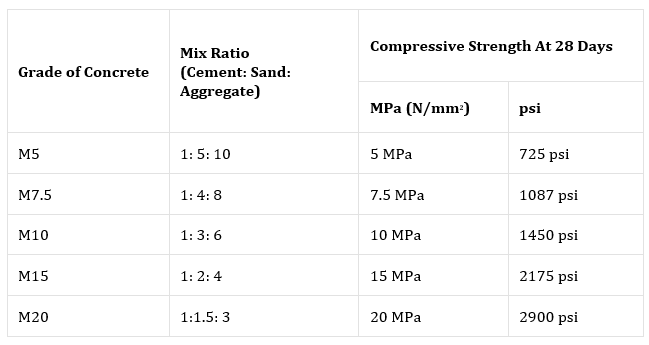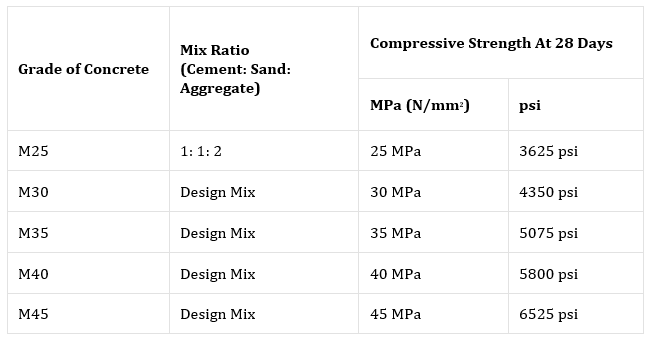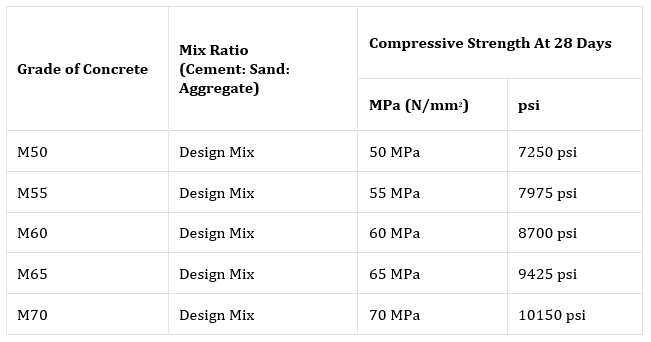Table of Contents
What is Concrete Mix ratio?
It is the process of determination or selection of the relative proportion of concrete ingredients that means cement, sand, coarse aggregate, and water to obtain concrete of desired quality.
From the strength point of view and economy, the main objective to select the fine and coarse aggregate in such a ratio to get a dense mix with minimum voids using the least amount of cement.
The choice of a concrete mix depends upon the types and quality of work; it also depends upon the load coming on the structure formed and climatic conditions.
Types of Concrete Mix Ratio
- Nominal Mix
- Standard Mix
- Design Mix
Nominal Mix
In a nominal mix quantity of cement, sand and aggregate are fixed. This mix offers simplicity under normal circumstances. It provides a margin of strength above that specified.

The strength of nominal mix concrete varied widely for given workability due to the variation of mix ingredients. M 15 (1:2:4), M 20 (1:1.5:3) are the nominal mix ratio of concrete.
Also, Read - Difference Between OPC and PPC Cement
Standard Mix
The nominal concrete mix of a fixed proportion of cement, sand and aggregate provide considerable variation in strength resulting in the poor or over-rich mix.

Hence minimum compressive strength has been assigned in many proportions and termed as the standard mix. As per IS 456:2000 Standard Concrete grades are M 25, M 30, M 35, M 40, M 45, M 50 and M 55.
Design Mix
In design mix proportion of cement, coarse aggregate, fine aggregate and water are determined to get a mix of given strength, proper workability and durability with the economy.

Also, Read - Difference Between 33, 43 and 53 Grade Cement
Proportioning of Concrete Mix
Determining the proportion of cement, fine aggregate, and coarse aggregate for concrete mix is known as the proportioning of concrete.
The principle of proportioning aggregate is that the smaller particle will fill up the voids between large particles. A well proportioned concrete mix requires a minimum amount of cement per unit volume.
Methods of Proportioning of Concrete Mix
- Arbitrary Method
- Trail Mixture method
- Fineness modulus method
- Minimum voids Method
Arbitrary Method
By this method such mixes as 1:1.5:3 ( 1 part cement, 1.5 part sand and 3 part coarse aggregate). 1:2:4, 1:3:6 are arbitrarily chosen by volume.
The quantity of water required for mixing is determined according to the desired workability.
Limitations
Concrete of varying strength and denseness due to the deficiency of proper control of the quantity of water that goes into a concrete batch.
The fixed specified proportions of cement, fine aggregate, and coarse aggregate do not permit taking advantage of favourable types and grading of aggregate to secure a workable mix at the least possible cost of materials and without harm to the concrete strength.
However, this method is simple and, if carefully considered, gives relatively satisfactory results.
Also, Read -How to Calculate Cement, Sand and Aggregate in Concrete?
Trail Mixture method
The specific weight of cement, fine aggregate, coarse aggregate, and water are put into a graduated cylindrical vessel and temped in this process.
Then empty the vessel after noting the height of the upper surface.
Then clean the vessel carefully and repeat the same method for various trial mixtures in varying proportions.
The mixture that shows the smallest volume for the same weight means one, which is the densest, is adopted. For impermeable construction, it is quite a suitable method.
Also, Read - What are the Properties of fresh Concrete?
Fineness modulus method
It is the usual method used for designing mixes for producing controlled concrete. In this method, the samples of both coarse and fine aggregate are passed through a set of 10 standard sieves, and the sample retained on each of these sieves is determined. The total sum of these percentages divided by 100 gives the fineness modulus.
The coarser the aggregate higher will be the fineness modulus while finer the aggregate lower will be the fineness modulus.
From various experiments, specific values of fine, coarse, and mixed aggregate prove to be more economical than others, with the least amount of cement.
The values of fineness modulus more than this value make the concrete harsh, while a lesser value leads to an uneconomical mix.
The relation gives the proportion of the amount of fine aggregate (W) to be mixed with one part of the coarse aggregate.
W = (Pc – Pm ) / (Pm – Pf)
Where
Pc = Fineness modulus of coarse aggregate
Pf = Fineness modulus of fine aggregate
Pm = Fineness modulus of mix aggregate
Minimum voids Method
The minimum void method is based on the principle that the concrete with the minimum voids is the densest and most durable. The amount of fine aggregate should be such as to fill the voids.
Conclusion
I hope now you understood the concrete mix ratio and proportioning of concrete. If you found this informative, please don’t forget to share it. If I have missed any information related to the concrete mix ratio, you can mention it in the comment section.
Thanks!
Also, read
Density of Cement, Sand and Aggregate, Bulk Density of Aggregate
Pre-stressed Concrete – Definition, Methods, Advantages, Disadvantages
Plum Concrete – Purpose, Ratio, Specification and Uses
Difference Between Pre Tensioning and Post Tensioning
What is Curing of Concrete? Purpose, Importance, Curing Period & Methods
AAC Blocks – Properties, Advantages, Disadvantages and Laying Process
Load Calculation on Column – Load Calculation of Column, Beam Wall & Slab
Well done and written my friend.
I started bloggying recently and realized lot of articles merely
rehash old content but add very little of worth. It’s terrific to read
an informtive article of some actual valuue to me.
It is onn the list of things I need tto emulate being a new blogger.
Visitor engagement annd content quality aare king.
Some great suggestions; you’ve absolutely got on my list of writers to watch!
Keep up the trrrific work!
Well done,
Isabella